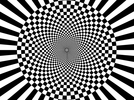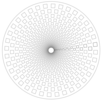Laser-cut objects
The first PostScript printers appeared in 1985, while I worked on the COHERENT operating system for Mark Williams Company. I learned the PostScript language to implement a PostScript back end for the COHERENT troff text processor. PostScript is far from user-friendly, so not many people write PostScript programs directly, but it is powerful and straightforward. In the ensuing years, I wrote small PostScript programs for T-shirt designs, business cards, and graphics like the Spiros Horemis design at right.
In late 2009, former Mark Williams Company owner Bob Swartz hired me to work for his current venture. At his lab in the north suburbs of Chicago, Bob has an Epilog Mini-Helix laser cutter/engraver (24" by 18" bed, 45 w. laser), shown at left and in close-up during operation at right. Once I figured out how to drive the laser cutter, I realized I could use PostScript to create laser-cut objects. Bob's machine made all the objects on this page from my PostScript programs.
Once I have a design idea, I write a PostScript program to render it as a line drawing. For example, I modified the Horemis design shown above to the line drawing shown at left. At home in SF, I render PostScript directly on a computer display using software (GhostScript) or print a hard copy on a printer. At Bob's lab in Chicago, I import the .ps into a drawing program and print it to his laser cutter. The laser cutter then cuts the lines in the drawing, producing an object as at right.
My PostScript programs are parameterized to make them more general. For example, parameters in the polygonal spiral program poly_spiral.ps specify the number of sides in the polygon, the number of spirals, the number of divisions between the center and the outer edge, and the desired object size. As a result, one program can produce many different objects: poly_spiral.ps with only the number of sides and spirals changed produces the spiral at left with 6 sides and 3 spirals and the spiral at right with 720 sides (so it looks like a smooth spiral) and 2 spirals. All the programs to date are quite simple; most are about a page of code. A compressed tarball of the program sources is here.
The laser cutter can cut many different materials. To date, I've used it to cut paper, card stock, cardboard, masonite, plywood, acrylic, and polyethylene. The acrylic and masonite pieces are the nicest. Because it cuts so precisely, you can swap pieces from two copies made of different material, as shown at left and right. As of March 2011, I've used the Epilog only to cut; it can also engrave, but that remains for future exploration.
Click on any image to enlarge, then use the back arrow on your browser to return.
Credits
First and foremost, thanks to Bob Swartz for his great generosity. Without complaint, Bob allows me to fiddle with his laser cutter while I should be doing more productive work.
horemis is based on a work by Spiros Horemis. delaware and marrakech are based on Frank Stella's paintings Delaware Crossing and Marrakech. op_art is based on an op art picture I found on the web, uncredited IIRC. The ideas for golden_frame and poly_spiral are based on John Edmark's amazing objects at johnedmark.com.



































